Current topics
The 8th Meeting of the Regional Environmental Sustainable Transport (EST) Forum in Asia
Next Generation Solutions for Sustainable Transport

Group photo of the Conference
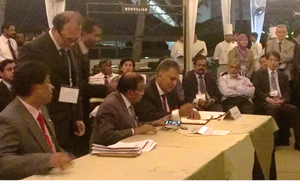
The Signing Ceremony of the Addendum to Kyoto Declaration
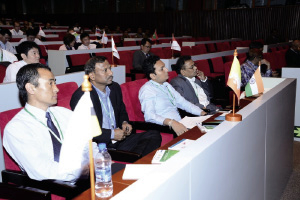
Government representatives in the meeting
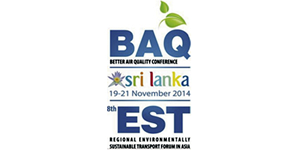
The Ministry of the Environment (MOE), in cooperation with the United Nations Centre for Regional Development (UNCRD), the Ministry of Environment & Renewable Energy and the Ministry of Transport of Democratic Socialist Republic of Sri Lanka, and Clean Air Asia co-organized the 8th Regional EST Forum in Asia in Colombo, Sri Lanka from November 19 to 21, 2014. This time, the meeting was integrated with the International Conference on Better Air Quality 2014 (BAQ2014) and attended by approximately 1,000 participants.
The Regional EST Forum in Asia was established by MOE and UNCRD in 2005, which has been successfully promoting cooperation towards the realization of Environmentally Sustainable Transport (EST) in Asia through policy dialogues with Asian countries.
The 8th Forum adopted the Colombo Declaration for the promotion of next generation low-carbon transport solutions in Asia, with the participation of about 230 individuals including senior government officials (e.g. from environmental and transport related Ministries) of 21 Asian countries, academic experts in the fields of transport and the environment, and those involved in intergovernmental organizations. In the forum, the Special Event of Asian Mayors was held which the mayors and city representatives adopted the Addendum to Kyoto Declaration towards Realizing Resilient, Smart, and Livable cities in Asia.
MOE will, in close cooperation also with relevant organizations such as the Ministry of Land, Infrastructure, Transport and Tourism, actively continue to work on the realization of EST with the focus on Asia.
More Information:
The Leading Low-carbon Technology (L2-Tech) List (Draft) in Fiscal 2014
The L2-Tech List for Initiating of "the Best Standards"
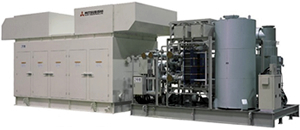
The Cogeneration system - producing electricity and heat from gas
By 2050 we need to reduce 80% of GHG emissions within the ecological constraints of "Only One Earth." For this purpose, it is essential to promote drastic implementation and deployment of low carbon technologies. This time, we have conducted surveys on, and made a list of, the levels of the most leading and efficient facilities and equipment (L2-Tech) among technologies that can be the key to the realization of a low-carbon society.
For example, a heat pump that collects and utilizes heat from the ambient air is a technology used in various situations in Japan (e.g. heat sources and air conditioners at factories and offices, and home air conditioners and washing machines). The cogeneration system produces electricity and heat through the highly efficient utilization of the energy that is originally contained in fuels, which is also used at home by downsizing the system for industrial use. Plug-in hybrid cars that can charge batteries directly from domestic power sources can increase the proportion of electrical driving.
Such information will be utilized mainly for the MOE's measures for technology implementation assistance, technology development and demonstration projects. We will promote a drastic reduction in energy-originated CO2 emissions, aiming to build a low-carbon society through the domestic and international transmission of the "best" information that can be widely utilized as references for technology implementation by various entities such as businesses, local governments, NPOs and citizens.
Technology advances daily. We will continue to work on organizing basic L2-Tech information and establishing and enhancing effective methods for updating the list.
More Information:
Table: Contents of the L2-Tech List (Draft) (As of December 2014)
| Field | Classification and Industry Sector, etc. | Image of L2-Tech Standard Level |
|---|---|---|
| A: Industry and commercial(common to sectors) | Air conditioning, Heat sources, etc. | ![Image of [Pursuit of Best] Type(Fluid standard (L2-Tech Standard), proactive)](image/topi02c.gif) |
| B: Industry (sector-specific manufacturing equipment, etc.) | Iron and steel, Chemical, Paper and pulp manufacturing, Petrochemical, Glass-making, Automobile manufacturing, Construction machinery, Agricultural instruments (for cultivating), Agriculture (horticulture facility), etc. | |
| C: Transportation | Automobiles (passenger cars), Automobiles (commercial vehicles, heavy vehicles), Two-wheeled vehicles, Railways, Shipping, Aircraft | |
| D: Residential | Household electric appliances, Water heaters, Window glass, etc. | |
| E: Energy conversion | Renewable energy, Thermal power generation, etc. | |
| F: Waste treatment and recycling | General waste treatment, Industrial waste treatment, Material recycling, Sewage treatment, Sewage sludge treatment, etc. |
- Information collected from industry groups and other sources was organized from scientific and objective viewpoints while getting input from relevant experts for respective technologies.
- This draft was compiled based on the information collected between April and July 2014. The "L2-Tech List in Fiscal 2014" is scheduled to be published in March 2015.
The Invasive Alien Species List of Japan and The Invasive Alien Species Control Action Plan
Towards Biodiversity Conservation in Japan
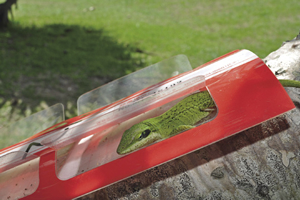
A trapped green anole (at the Ogasawara Islands)
The Tenth meeting of the Conference of the Parties to the Convention on Biological Diversity adopted the Aichi Targets that includes a statement as follows: "By 2020, invasive alien species and pathways are identified and prioritized; priority species are controlled or eradicated."
In this regard, in March 2015, the Ministry of the Environment (MOE) and the Ministry of Agriculture, Forestry and Fisheries (MAFF) made the "Invasive Alien Species List of Japan" selecting alien species regardless of the legal regulation, harmful to the Japanese ecosystems, human safety, or agriculture and fisheries. Based on scientific findings, we have selected a wide range of species that include those non-established in Japan, those utilized as household pets and those useful for industry. We categorized them according to the measures to be taken and organized the species-specific information on the establishment status, considerations for their handling, etc. Currently, there are about 400 species listed, which is to be regularly revised.
Also, MOE, MAFF and Ministry of Land, Infrastructure, Transport and Tourism formulated the "The Invasive Alien Species Control Action Plan" that sets out eight basic concepts and numerical targets for each to promote alien species management including priority for control, and presents the action plan of government that should be implemented towards achieving the targets. In addition to above, the action plan has summarized the current statuses of alien species issues in Japan, and organized roles and action guidelines for each entity.
In their formulation, we collected opinions from academic experts, business organizations and various citizens, which generated a very high level of interest.
Towards biodiversity conservation, we will promote measures against alien species, utilizing the List and the Action Plan.
Categories of the Invaise Alien Speaies List of Japan
Alien species subject to establishment prevention
Non-established species in Japan. They need to be prevented from introduction, monitored at the border, prevented from escaping to and being established in outdoor settings, and removed at early stages once identified.
Alien species subject to invasion prevention:
Uninvaded species in Japan Invasion into Japan needs to be prevented, in particular, by introduction prevention, border monitoring and ballast water management.
Other alien species subject to establishment prevention:
Species with reported information on invasion, but with no confirmation of their establishment
Alien species requiring comprehensive measures
Species with confirmation of their establishment. Alien species that require comprehensive measures such as dissemination and awareness raising of removal (e.g. removal in the field and expansion prevention) and prevention of abandonment, introduction and escape under the respective roles of the central government, local governments and citizens.
Alien species requiring urgent action:
Urgent action is required to actively remove the species, in particular, under the respective roles of each entity.
Alien species requiring priority measures:
Because significant damage is expected, there is a strong need for countermeasures to be taken, in particular, under the respective roles of each entity.
Other alien species requiring comprehensive measures
Alien species subject to industrial management
Alien species of industrial or public significance, and of non-substitutability, which thus require appropriate management in their use. Appropriate management is called for, indicating species-specific considerations for their use.





